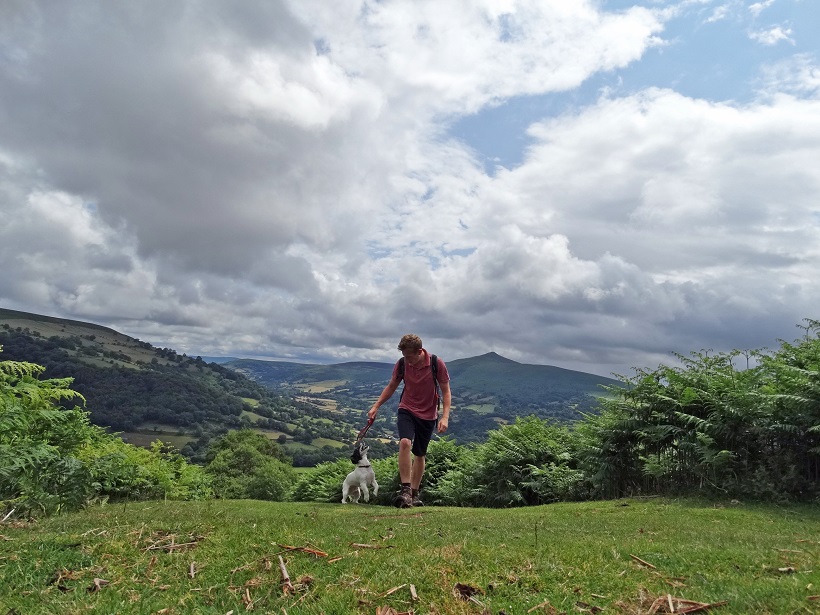Will Renwick is drawn to a curious collection of hills on the edge of the Brecon Beacons… and then drawn back again
Several bizarrely shaped peaks surround the house that geographer George Everest was born in. One is a bent finger, one a great lump struck in two, another is steep on all sides but level as an altar on top. And there are more.
I like to think that these strange contortions sowed the seeds for Everest’s future career; made a young boy eager to understand the landscape, eager enough to go on to become the man who would ‘discover’ the world’s highest mountain, or at least, lead the survey that would identify it as such. These aren’t 15,000ft peaks though. They aren’t even 2,000ft ones, so they fail to qualify as mountains at all – by the British 610m standard anyway. These are hills.
Surrounding the two market towns of Crickhowell and Abergavenny at the far eastern reaches of the Brecon Beacons, each hill sits entirely separate from each other but all are within the shadow of the Black Mountains, like overspill from their abrupt halt. That’s not to say they are eclipsed though – these weird and wonderful lumps are so curious, so clearly pronounced that they demand attention.
They are charming. I feel reluctant to use such a cliché but it’s unavoidable. You only need to read their names to understand why: the Sugar Loaf, Table Mountain, Ysgyryd Fawr (which translates as ‘great shiver’ or ‘shattered’) and the Cat’s Back, all complete reflections of their form.
Yes, these are technically hills, but as I found out from two separate trips over the summer, our criteria for a mountain serves to misrepresent them. And I think even the great mountain measurer George Everest might have agreed. Each of these hills has its own quirk, its own thrills to provide – and certainly a tale or two attached.
Ysgyryd Fawr or the Skirrid
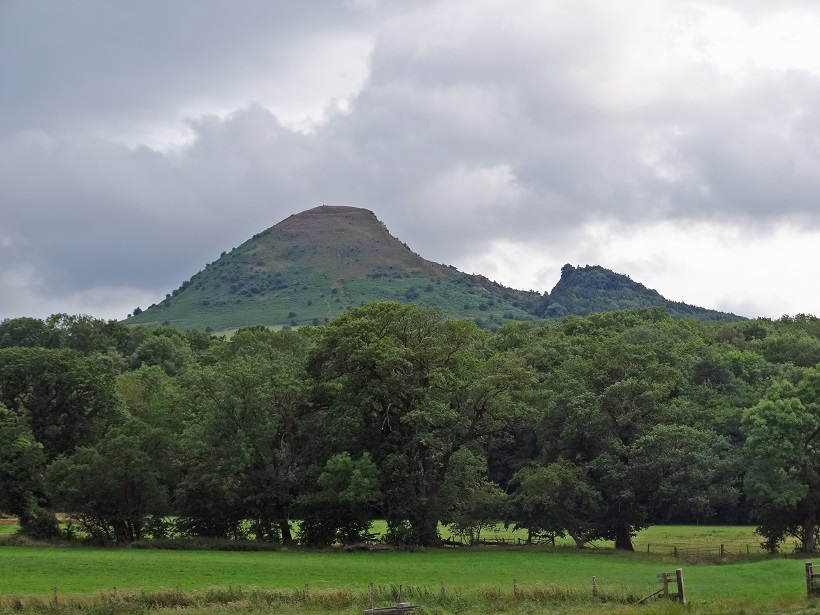
One hundred and eighty criminals were said to have been hanged from the oak beam over the Skirrid Inn’s staircase, and the trace of the rope supposedly still remains. Now the ‘Hanging Judge’ and his victims are believed to haunt the pub – to such a degree that they’ve earned it the the reputation of being one of the UK’s most haunted places.
The hill that the inn takes its name from – and sits at the foot of – is also a place of great myths. Step out from the pub and you will see that the hill is divided, sliced in two as if by one single blow. And that is what several local legends purport, the pub sign itself showing a lightning bolt striking through the peak. The most popular myth is that at the moment of Christ’s crucifixion the mountain shook, shuddered and split. Scientific explanations are less exciting, they point to it either being a result of glacial movement during the ice age, or a mega landslide inevitably coming about due to the sharp angle of its slopes.
Ysgyryd Fawr is only 486m high, but it’s a prominent little pocket rocket. Its twin peaks have been described as an ‘upturned ship’, pointed above the gently flowing fields that surround it. On my first visit of the summer to this part of Wales, it draws me like a bee to honey. I make it my first goal on a day exploring the area.
The climb initially takes me through the hill’s woodland necklace on a zig zagging rise through oak and beech trees. It’s easy to find the way up, being led by a path cut into the red earth. This dirt is precious, it was once believed to be sacred and would draw thieving farmers looking to spread it on their own land:
Just like the farmers who once came to scoop
handfuls of soil from her holy scar,
So I am still drawn to her back for answers
to every question I have never known.
These are the words of Owen Sheers, taken from his poetry collection named after the “hair-lipped”, “broken spine of soil”. The running theme of the collection is, of course, separation.
Once I have broken through the woodland I am on the hill’s bald head and can see the remains of St Michael’s chapel. The elements have reduced it to two stones that form a doorway to the summit and its trig point. I’m on Wales’s own St Michael’s Mount. Here, with three steep drops on all sides of me I see field after field, all heading south until they stumble into a crack known as the Wye Valley. In the west stands the pointed Sugar Loaf, my next hill.
Sugar Loaf
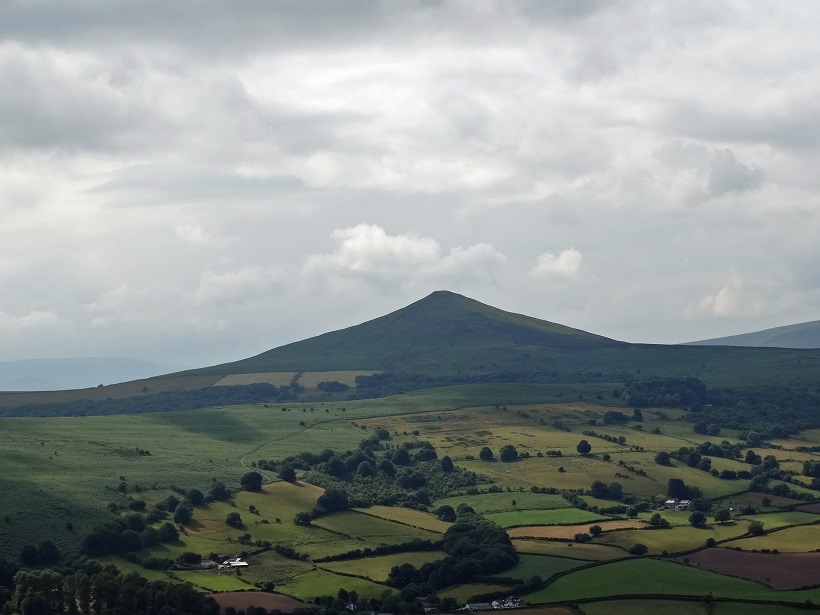
My car clanks up the steep lane to the parking spot on the slopes of the Sugar Loaf. The bumper scrapes as I round one of the hairpin turns and, by the time I reach the car park, the town of Crickhowell is tucked so tightly in the valley below that it’s out of sight. I can see the top of the Sugar Loaf ahead of me, settled like sand in an hourglass… and it’s not very far away. I realise I’ve driven up most of the hill, and feel a bit ashamed of myself.
Ten minutes of walking and the top doesn’t seem to be getting any nearer. All that surrounds the hill is a jungle of ferns, there’s nothing to help gauge distance whatsoever, not even a solitary tree. But I can see that the red path narrows, and then is driven by the contours to snake upwards. This is a bit of a walk after all.
Eventually I’m almost at a scramble, pulling myself up through two boulders with both hands. I’m climbing a mini Matterhorn.
Once on its needle-point I’m only at 596m but I feel intrepid. The wind funnelled up the Bristol Channel buffets me as I climb through stone arches and leap across the micro pinnacles on the boulder-strewn summit. In the north I can see onto the bleak curve of the Black Mountains, further west the flowing sandstone seam along Cribyn, Pen y Fan and Corn Du. In the east, I see back to my first peak: Ysgyryd Fawr. It was from here on the Sugar Loaf that the giant Jack o’Kent supposedly leapt, landing with such force that, you guessed it, Ysgyryd Fawr was split. Yet another tall tale to explain its scar.
Table Mountain
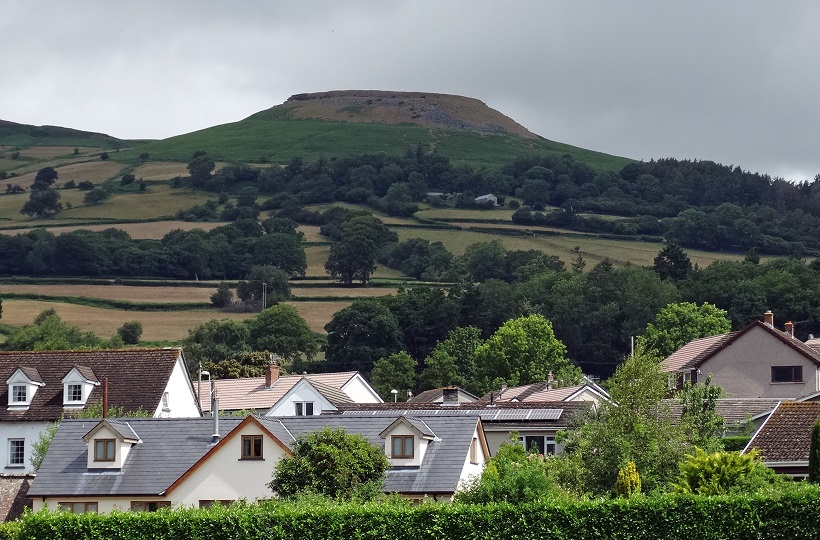
Just like the famous Table Mountain looms over the city of Cape Town, this lesser-known one looms over the little market town of Crickhowell. Cape Town is synonymous with its mountain and the same applies for Crickhowell – it’s even named after it, the Welsh name for the hill being Crug Hywel.
I begin my ascent from the Bear Hotel, going from the town’s centre to its boundary in the blink of an eye. I then pass through narrow lanes and eventually into sloping meadows where I slice through the thick grass. I’m climbing quickly until just short of the tabletop where things change. This hill is 159m short of being the 610m British standard for a mountain, yet within 10m from the top it certainly has the air of one. The green grass turns that lifeless colour that comes only above a certain height in Wales, and it makes the tabletop even more pronounced. The wind is strong, carrying the sound of the sheep from the mountains above.
To enter Table Mountain’s tiny plateau I cross through the defensive ditches of the Iron Age hillfort that once sat atop. The fort would have overseen the haven of farmland below and guarded it from the badlands of the mountains that are right on the doorstep. I could jump straight into the wild Brecon Beacons in a few paces. But I choose to keep with hills rather than mountains today, and after bearing the cold wind on the summit for long enough I make my way back to Crickhowell where the sun seems to still shine.
The Cat’s Back
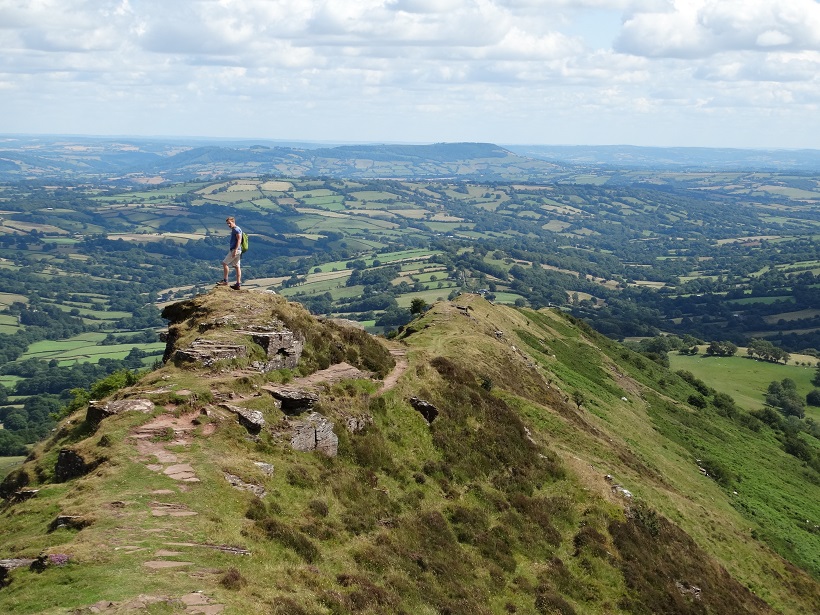
This is my epilogue. After Ysgyryd Fawr, the Sugar Loaf and Table Mountain I returned to my South Wales home content that I had explored all of the strange hills within this little idyll in south-east Wales, but by chance, while reading a book by Bruce Chatwin, I came to realise I had missed the best of them.
On the Black Hill is a fictional story about a pair of twins who grow up on the Welsh side of the border with England. It charts their lives from birth in the late 19th Century through to the 1980s when they are decrepit old men still living under the Black Hill together. Throughout the course of the novel Chatwin shows the world changing around them while they remain the same – just like the hill, their comforting constant above them. One of the main themes, like that of Owen Sheer’s Skirrid Hill collection, is separation. The Black Hill sits either side of the border with England; on one side, green fields, and wealthy communities and on the other bleak mountains and proud Welsh people living feudal lives.
I wondered if Chatwin’s Black Hill actually exists. A quick bit of research told me that it does.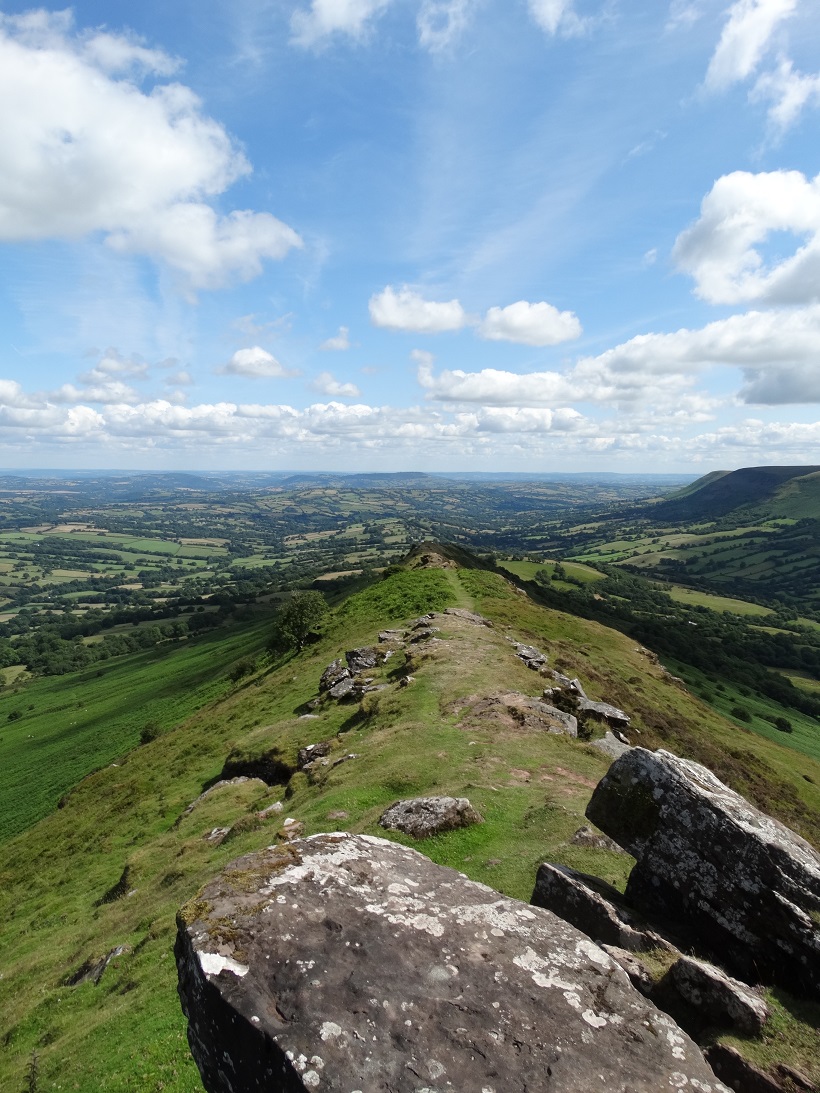
Images online showed me a hill known by many as the Cat’s Back, which by coincidence is in the same part of the world as the hills I had previously spent the day exploring. It had been hidden from my view by the Black Mountains’ great fingers and I’d been oblivious to it. From what the images showed me, if I had seen it I would have certainly been lured up its slopes. I had to go back.
It’s said that from Herefordshire in the east, Crib y Garth looks like a black cat ready to pounce, hence its nickname. The appropriateness of this is apparent on the hill itself; it’s a narrow, knobbly spine with several curvatures. I rise up and the edges drop from me on either side forcing me to concentrate on my balance while I walk the line over its half-buried boulders and flat slabs. The drops aren’t too dizzying, but I still wouldn’t want to stumble down them. It feels like a proper ridge walk, yet I’m only at 500m and the sides aren’t black scree-lined but covered in a Herefordshire-green coat: a more casual Striding Edge or a friendly Crib Goch. Keep walking and with one more bump the Cat’s Back becomes a big and broad actual mountain (640m), but the fun is here on its mini ridge, enjoying the exhilaration that a drop always brings.
I pause on one of the higher of the Cat’s arches to take in the view. Now I can fully understand why Crib y Garth conjured up ideas of division and separation to Chatwin. The differences on either side of this border-lying hill are stark, they are two different worlds. In the west: the high, black wilderness of the Welsh mountains and silence. In the east: Herefordshire’s low meadows and orchards that only rise with the distant Cotswold Hills. There’s a hint of the Malverns beyond as well. The hum of a busy tractor rises up.
This sense of separation gets greater for me as I make my way back home. It’s felt in a very different way though. I don’t want to leave. To roam around this corner of Wales is like wandering around a theme park, with each hill an eye-catching ride that lures you to climb onboard for a short and sharp burst of exhilaration. I want to see what other mini mountains I can find tucked away here.

Base camp
A quest to visit all four of these mini mountains will make for a fun weekend away, and it’s worth considering Crickhowell as a base. The Sugar Loaf and Table Mountain are right on its doorstep and Ysgyryd Fawr and the Cat’s Back just on to the east. Make sure to walk across the market town’s 18th Century stone bridge over the Usk (supposedly the longest bridge in Wales at 128m) and to pay a visit to the Bear Hotel (www.rarebits.co.uk/bear), a 15th Century inn that’s one of Wales’ finest walkers’ pubs.

